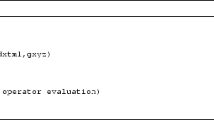Abstract
The Fast Multipole Method (FMM) is specially suitable for applications in which it is necessary to predict the acoustic scattering, e.g., aircraft noise control. This accelerated iterative method has two main parts, far interactions and near interactions. Near interactions are computationally intensive and they fit properly in the Single Instruction Multiple Threads paradigm. In this work, we present a heterogeneous parallel solution in which the near interactions are computed using Graphical Processing Units (GPUs). The performance of the proposed solution is proved using a workstation with one NVIDIA GTX480 GPU and a cluster that consists of 32 nodes HP BL465c with an Infiniband network.
Similar content being viewed by others
References
Abramowitz M, Stegun IA (1972) Handbook of mathematical functions. Dover, New York
Advisory Council for Aeronautics Research in Europe (2008) 2008 addendum to the strategic research agenda, available online at: www.acare4europe.org
Burton AJ, Miller GF (1971) The application of integral equation methods to the numerical solution of some exterior boundary-value problems. Proc R Soc Lond 323(1553):201–210
Gumerov NA, Duraiswami R, Borovikov EA (2003) Data structures, optimal choice of parameters, and complexity results for generalized multilevel fast multipole methods in d dimensions. Institute for Advanced Computer Studies
Marburg S, Schneider S (2003) Performance of iterative solvers for acoustic problems. Part I. Solvers and effect of diagonal preconditioning. Eng Anal Bound Elem 27(7):727–750
Owens JD, Houston M, Luebke D, Green S, Stone JE, Phillips JC (2008) GPU computing. Proc IEEE 96(5):879–899
Rokhlin V (1993) Diagonal forms of translation operators for the Helmholtz equation in three dimensions. Appl Comput Harmon Anal 1(1):82–93
Saad Y, Schultz MH (1986) GMRES: a generalized minimal residual algorithm for solving nonsymmetric linear systems. SIAM J Sci Stat Comput 7:856–869
Song J, Chew W (1995) Multilevel fast-multipole algorithm for solving combined field integral equations of electromagnetic scattering. Microw Opt Technol Lett 10(1):14–19
Volkov V, Demmel JW (2008) Benchmarking GPUs to tune dense linear algebra. In: Proceedings of the 2008 ACM/IEEE conference on supercomputing, pp 1–11
Wu TW (2000) Boundary element acoustics, advances in boundary elements. WIT Press, Ashurst
Author information
Authors and Affiliations
Corresponding author
Rights and permissions
About this article
Cite this article
López-Portugués, M., López-Fernández, J.A., Rodríguez-Campa, A. et al. A GPGPU solution of the FMM near interactions for acoustic scattering problems. J Supercomput 58, 283–291 (2011). https://doi.org/10.1007/s11227-011-0584-6
Published:
Issue Date:
DOI: https://doi.org/10.1007/s11227-011-0584-6




